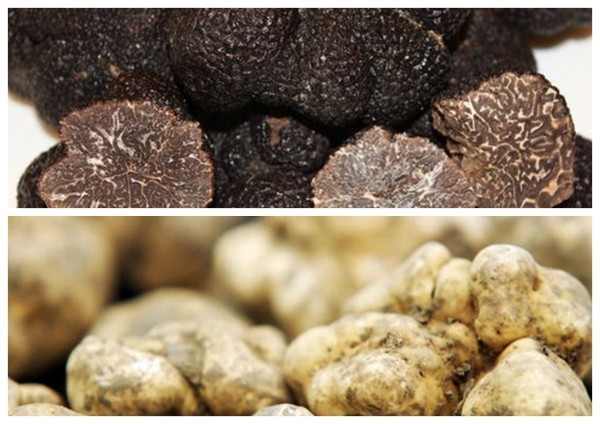
Black truffle photo (top) by Constance Hotels & Resorts, white truffle photo (bottom) by Life in Italy
In a nutshell | Black truffles are less expensive, come from France and are best served cooked, while white truffles are costlier, come from Italy and are best served raw
Colour aside, there are more differences between the two truffles than most are aware of. Firstly, black truffles are best served cooked (e.g. heated and blended into sauces, creams and stews), while white truffles are best served raw (e.g. grated directly onto food as a topping). Also, white truffles are way more expensive than black truffles; one pound of white truffle can cost anywhere from 1000 to 2000 USD, while it’s 400 to 700 USD for one pound of black truffles.
Additionally, this one’s an Italy VS France difference. White truffles are mostly from Italy, while black truffles can be found in France.
Croque Monsieur VS Croque Madame

Croque Madame photo (left) from Tumblr, Croque Monsieur photo (right) by Chatelaine
In a nutshell | Croque Madame is a Croque Monsieur topped with an egg
The Croque Monsieur is basically the French version of a cheese sandwich. It was introduced to menus all over Paris in 1910 and consists of ham and gruyere cheese, and is fried in butter. Today, this deliciously sinful creation is still a popular French staple. However, you might have seen a ‘Croque Madame’ on the menu of eateries such as Pique Nique and Skyve before. Ever wondered what the difference was?
Well, it’s very simple. The Croque Madame is essentially a Croque Monsieur, just that it has a sunny side up egg on top!
Bechamel VS Veloute VS Tomato VS Espagnole VS Hollandaise (the 5 mother sauces)

Photo by sharperknife
In a nutshell | Tomato sauce aside, espagnole is much darker and way stronger in flavour compared to veloute, and bechamel is a milk sauce while hollandaise is mainly a butter-and-egg sauce
If you’re serious about cooking (or eating), you have to know the five mother sauces. A term established by two French men, Antonin Careme and Chef Auguste Escoffier, in the 19th century and 20th century respectively, the five French mother sauces consist of bechamel, veloute, tomato, espagnole and hollandaise, and in order to make any kind of sauce, you’d have to know how to make each of these sauces and understand the differences.
While tomato may be the most obvious “odd one out”, many often can’t differentiate between espagnole and veloute, and bechamel and hollandaise.
Espagnole and veloute may look similar, but note that espagnole is much darker in colour compared to veloute. White stock is used as a base for veloute (usually veal, but fish and chicken are also common), while the base for espagnole is almost always roasted veal stock. Espagnole is usually served with roasted meat, while veloute is served with eggs, fish, steamed poultry and vegetables and pastas.
As for bechamel and hollandaise: bechamel is basically a milk sauce, while hollandaise is made of butter and eggs. Hollandaise also tends to be bright yellow in colour, while bechamel is a pale white-yellow colour.
Escargot VS garden snails
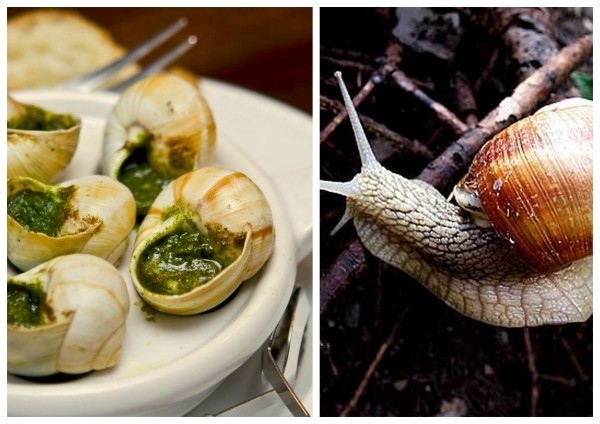
Escargot photo (left) by The Chubby Cook, garden snail photo (right) by Hans Kellner
In a nutshell | Land snails are used for escargot, just that they have to go through a strict purging cycle to remove harmful toxins
Yes, we’ve all thought about it before: are we eating the snails we find in our gardens as a delicacy?
Unfortunately, the awful truth is that we are eating land snails served to us on a metal platter topped with garlic and drowned in butter. Yikes. But before you freak out, know that these aren’t just plucked from some random green patch of grass and immediately served to us.
The three snail species selected are Helix pomatia, Helix aspersa and Helix lucorum, and it’s only these three. Before being sent to kitchens all over the world, these snails are put through a two-week purging cycle to rid them of toxins that might be harmful to humans, such as insecticide for example.
So, it really isn’t a good idea to go picking your own snails if you’re craving for escargot. Best pay for a platter at a restaurant, or pick a pack up from the supermarket because those are definitely “clean”.
French vanilla VS regular vanilla
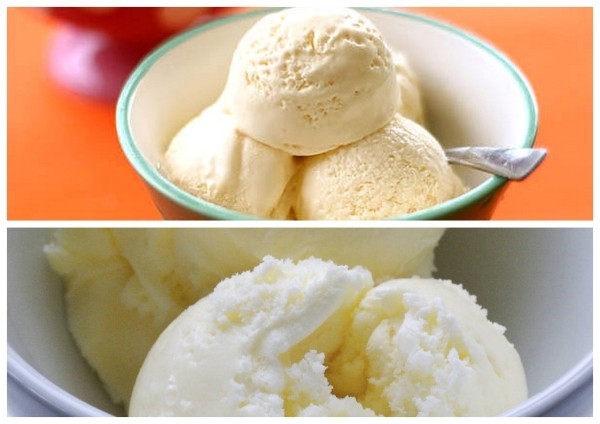
French vanilla photo (top) by AZ Cookbook, vanilla photo (bottom) by All the Meals
In a nutshell | Regular vanilla has a base of cream or milk (which explains the white colour), while French vanilla has a thicker, creamier custard base and is yellow in colour
In case you haven’t noticed, there is regular vanilla and French vanilla and these two ice cream flavours are not the same. While both contain vanilla beans, their bases are different: classic vanilla has a base of cream or milk, while French vanilla boasts a custard base that goes through a heating process. In other words, egg yolks are used to produce its thick, creamy texture. This is also why French vanilla is much more yellow in colour compared to classic vanilla.
Rice VS risotto

Rice photo (top) by FinSki's, risotto photo (bottom) by Simply Recipes
In a nutshell | Unlike regular rice, Arborio – the official name of the rice used in risotto – is starchy and when cooked as a risotto, comes out creamy and pasta-like
Firstly, let’s get something straight: risotto is not the name of the rice grains used in the dish. Instead, risotto refers to the cooking technique used for a native Italian rice, Arborio – which is the official name of the rice found in risotto.
Now that we’ve cleared that up, if you’re thinking of using regular rice instead of Arborio rice to cook risotto – think again. Arborio is a medium- to long-grain rice that is fat and has a layer of soft starch on the outside. When making risotto, the super absorbent and starchy Arborio rice helps create the risotto’s pasta-like, creamy quality – something you simply cannot achieve if you use regular rice as they aren’t as starchy.
Olive oil VS extra virgin olive oil
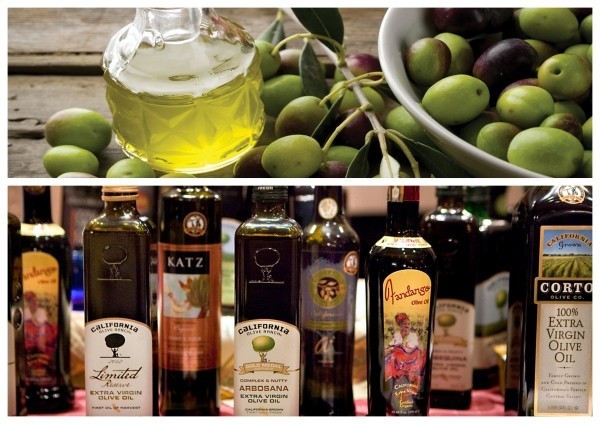
Olive oil photo (top) by The Healthy Haven Blog, extra virgin olive oil photo (bottom) by Karen Castillo Farfan / NPR
In a nutshell | Compared to extra virgin olive oil, pure olive oil is not as expensive and flavourful
There are many kinds of olive oil but let’s take a look at the basic difference between pure olive oil and extra virgin olive oil.
Pure olive oil is made mostly of processed olive oil and contains only a very small amount of extra virgin olive oil. It’s not as expensive as extra virgin olive oil and because its fruity olive flavour is not that strong, pure olive oil is great for baking (can you imagine biting into a olive oil-tasting cupcake? Gross...)
On the other hand, extra virgin olive oil is the highest quality olive oil with superb flavour. It’s produced from the first cold pressing (cold pressing means that no chemicals or heat have been used in the process) of the olives and pits. Because of its strong flavour, extra virgin olive oil is best enjoyed as a salad dressing and in bread dips.
Balsamic vinegar VS balsamic vinaigrette
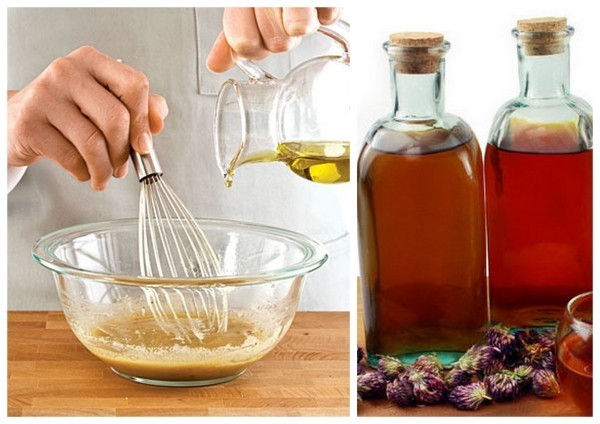
Balsamic vinaigrette photo (left) by Cooking Light, balsamic vinegar photo (right) by The Mountain Rose Blog
In a nutshell | Balsamic vinegar is healthier compared to balsamic vinaigrette, which contains oil, sugar and/or mustard
This one is a must-know for health freaks. With plenty of beneficial antioxidants, practically no fat and very few calores, balsamic vinegar is way healthier than balsamic vinaigrette. Balsamic vinaigrette is the sinful version of balsamic vinegar – together with seasonings such as salt, pepper and garlic, it also contains oil, sugar and/or mustard. So if you don’t want those extra calories, always opt for balsamic vinegar instead!
See Also:
Enjoy more variety of French food here
More Italian food to satisfy your tastebuds